Fall Flowers Are Important for Pollinators and Birds
Posted on Tuesday, September 26, 2023 · Leave a Comment
Despite my best efforts to support monarch butterflies, this year was discouraging: I only saw two monarchs visit my gardens. I have a small bed just for milkweeds, both the common one and swamp milkweed (Asclepias incarnata). But no monarchs laid eggs there this summer, no larvae ate the leaves, and I saw no butterflies sampling the nectar.
I know the importance of food for migrating monarchs at this time of year. They need to fill up on carbohydrates, fats and protein before flying long distances. That holds true for birds, too. Right now I have plenty of flowers blooming for monarchs and other pollinators, and seed heads waiting for the birds. I’m a bit discouraged, too, by the lower numbers of birds I am seeing. Let’s take a look at some of my fall favorites that migrating creatures could be feasting on.
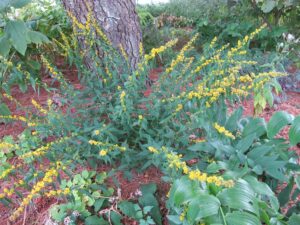
Blue stemmed goldenrod or Solidago caesia grows in shade
According to Doug Tallamy, the guru of native plants for pollinators, the number one plant we should all have is golden rod – and we probably all do. There are dozens of species of native goldenrod, all popular with bees, moths and butterflies. Many gardeners pull them out when they show up uninvited. A few species spread by root and can take over a flower bed – but others are clump-forming. Even if you don’t want them in your beds, think about leaving them at the edges of your fields or woods.
Of those species easily found for sale in garden centers, the best is Soldidago rugosa ‘Fireworks’. This plant is 3 to 5 feet tall, and stays in an ever-expanding clump in full sun or part shade, but does not take over. Its blossoms last a long time, the stems curving gently outward, like fireworks. And no, goldenrod does not cause hay fever – that is ragweed, which blooms at the same time.
Less common is blue-stemmed or wreath goldenrod (Solidago caesia). I bought a plant 20 years ago and it is blooming now in dry shade. It really has not expanded its reach very much. It grows just 1- to 3-feet tall, but usually is about 18 inches for me. It has delicate flowers that help light up a dark spot.
New York ironweed (Vernonia noveboracensis), is a tall native plant in the aster family with purple blossoms. It is still blooming for me, a month after starting to bloom. It does this by producing lots of buds which open sequentially – so it is not always a dramatic flower in a vase. But the bees love it. It is happiest in full sun in moist soil, but there it got too big for me, so I moved mine to dry soil with only morning sun. Now it is more manageable, but still a big plant. I’ve read that if you cut it back to the ground when it is 2-feet tall, it will stay smaller – but I never remember to do so. Sigh.
Speaking of asters, there are many native species, all good for pollinators and loved especially be monarch butterflies. This year the woodland asters are quite dramatic. They are a pale lavender, and grow in shady places. Elsewhere a taller wild cousin stands 4 to 6 feet tall with deep purple or pink flowers. These grow in full sun and are often seen by the roadside at this time of year. Asters of all sorts are readily available at garden centers. Ask for native ones, not fancy hybrids.
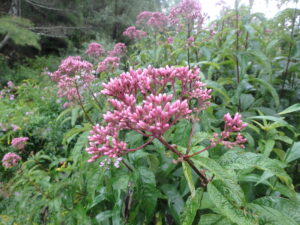
Joe Pye weed ‘Gateway’ blooms longer and better than wild forms
Joe Pye weed (Eutrochium purpurea) is another tall plant in the aster family. It can get huge – over 6-feet tall if grown in rich, moist soil. A named cultivar called ‘Gateway’ has longer lasting flowers and richer colors than the wild ones, though those are nice, too. Smaller varieties such as Little Joe, Baby Joe and Phantom are nice, and better suited for smaller gardens. I haven’t grown them but see they are sold as being 3- to 4-feet tall. Monarchs and other pollinators love them. All appreciate soil that does not dry out.
One tall annual that monarchs love is Brazilian verbena (Verbena bonariensis). It grows tall stalks that are remarkably tough – they grow 4 or 5 feet tall, but rarely need staking. Its flowers are in small clusters. It often drops seeds which send up new plants the following year.
Lastly for pollinators, I have to recommend fall crocus – which is not a crocus at all, but a Colchicum. This is a bulb plant that flowers on a six-inch stem (actually the throat of the blossom) in pink, white or lavender. It sends up foliage in the spring that dies back, then each bulb sends up a cluster of blossoms in September, or even earlier. They do best in full sun and rich soil, but do fine with some shade. They like to be fertilized each year. I often see small bees and wasps buzzing around in the blossoms.

Colchicum or fall crocus
I know that many gardeners are already cutting back their flowers in preparation for winter. But hold on! Flowers with lots of seeds can be left as winter snacks for our feathered friends. Among the best are black-eyed Susans, purple coneflower, sunflowers, zinnias, Joe Pye weed, coreopsis, sedums and ornamental grasses. Wait until spring to cut those back so that finches, chickadees, cardinals and other seed-eaters can enjoy them, especially on those cold, snowy mornings when you don’t want to go fill up your feeder.
And of course, leaving some work for spring means less work now! So leave some seeds for the birds, and enjoy watching them in the winter.
What the Monarchs Need Now
Posted on Tuesday, September 14, 2021 · Leave a Comment
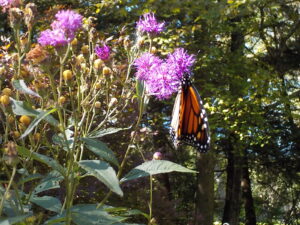
Monarch feeding on New York ironweed
Monarchs are on the move! It is time for their long trip to Mexico to spend the winter. And like marathon runners, they need to bulk up on calories before the event. You may have let a patch of milkweed grow on the edges of your property to support them. That is great, and many of us have done that. But the milkweed plants are for the caterpillars to munch on. Right now, they offer nothing to monarchs. Our monarchs need blooming flowers for nectar and pollen.
Of the monarchs I see floating around my gardens, three plants seem most attractive to them for feeding right now: Joe Pye weed, goldenrods and asters. Let’s look at these and their garden worthiness.

Joe Pye weed ‘Gateway’ blooms longer and better than the wild forms
Joe Pye weed (Eupatoreum maculatum) is a native wildflower that likes stream edges and places with good moisture, though it will grow almost anywhere it is planted. It is a big plant, often 5 or 6 feet tall in the wild. It is a clumping plant, with the clumps getting bigger every year.
It is readily found in plant nurseries, although most sold are a named cultivar, one called ‘Gateway’. I have found that Gateway blooms longer and does better in a vase than the truly wild ones that have popped up along my stream. There is now a smaller Joe Pye that is called ‘Little Joe’ that only gets to be three to four feet tall. It is a patented variety that does not breed true, and is actually a different species in the same genus, Eupatorium dubium. Then there is one called ‘Baby Joe’ but I have not yet tried either one.
The flowers of Joe Pye weed are a light purple and appear in large panicles at the top of the plant. The stems of Gateway are a deep purple, though the wild ones tend to be greener. Plant Joe Pye weed where you want it as the fibrous roots go deep into the soil, and when firmly established they are nearly impossible to dig out.
Goldenrods are a wonderful, though frequently maligned genus of plants. For many years they were prohibited in arrangements in the flower room at our county fair, as it was believed they caused hay fever. They do not. They have a heavy, sticky pollen that does not fly in the air but is transported by insects. There are at least 20 species of native goldenrods including some that prefer shade, while others demand full sun.
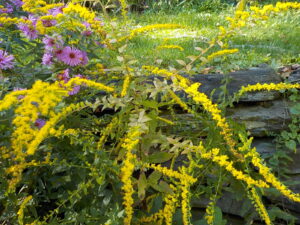
‘Fireworks’ goldenrod is commonly sold in nurseries now
Goldenrods are important not only for monarch butterflies, but also for many butterflies, moths, bees and other pollinators. And yes, some of the big, sun-loving species will expand their territory and send tenacious roots deep into the soil, even muscling out some dainty perennials.
Years ago I purchased some blue-stemmed goldenrod ( Solidago caesia) at The Garden in the Woods in Framingham, Massachusetts. I grow it in both dry shade and in rich soil in moist shade. It has never been a pest, or traveled around my garden beds, staying just where I planted it, blooming in September and into October. It is quite dainty.
My favorite goldenrod is a variety called ‘Fireworks’ of the species Solidago rugosa. It prefers full sun and moist soil, but I have also grown it in part sun and fairly dry soil. Its flowers are tiny, blooming first at the tips and working their way down the 3- to 4-foot stems. The stems arch gracefully like a fireworks display. They can be divided every 3 to 4 years to keep the clumps to a manageable size, and to increase (or share) them.
All the asters and aster-family flowers are great for monarchs and other butterflies. Scientists don’t call the genus aster any more, but Symphyotrichum, which is a shame as it is much less user-friendly.
There are at least 30 species of asters that grow wild in America, including many nice shade-loving ones that are certainly uprooted as weeds by tidy gardeners long before they bloom now, in the fall.
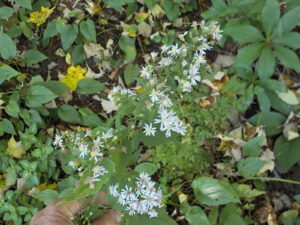
This woodland aster grows in shade as a wildflower
Asters have flowers with many rays and a bright yellow eye. They range from deep purple to white, along with pink and a light blue. All are quite tough, surviving any winter thrown at them.
Similar to asters, and a plant I just saw visited by a hungry monarch, is New York ironweed (Vernonia noveborancensis). It has smaller, deep purple blossoms in big clusters at the top of stems that can reach 9-feet tall.
According to Tracy DiSabato Aust, in her fabulous book, The Well-Tended Perennial Garden, shorter, later-blooming plants can be created by cutting back all the stems to the ground when they reach 2-feet tall. I shall certainly try that next spring. I moved mine from moist soil to dry soil in part shade partly because it got too tall in the full sun.
If you care about your monarchs, plant native plants. Native plants are much more useful to pollinators and wild animals than plants imported from other continents. Many of the native plants are just as beautiful and pleasing to me in the garden, and hopefully they are to you, too.









